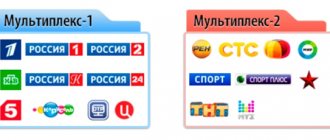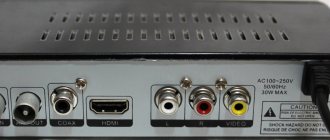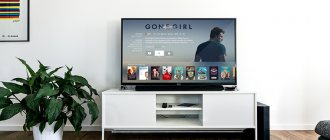With picture technology advancing faster than ever, High-Def has become the standard, giving TV buyers more options at lower prices. But what's different about all these confusing TVs, and what should you know before you buy one? If you're planning on buying a TV for a loved one (or just for yourself), this may help you know what to look for. Take a look to find out what sets HDTVs apart, learn some of the confusing terms associated with them, and see a comparison of the types of TVs commonly sold today. What are the differences between the types and types of TVs, what are the differences and classifications, types and formats, we will consider below.
CRT
If you bought a television in the late 1960s and 2000s, it was likely a cathode ray tube (CRT) set. Each CRT set has a vacuum tube with electron guns that fire red, green, and blue electrons onto a phosphor screen. The beams scan the dark screen, creating thousands of red, green or blue dots to create an image.
The technology dominated for three-quarters of a century—CRT TVs date back to the 1930s—and it wasn't until 2007 that sales of thinner, more versatile LCD monitors surpassed sales of CRT TVs.
Mechanical TV
John Logie Baird, Scottish engineer, creator of the first mechanical television system. Left – transmitter, right – receiver
Mechanical televisions were first assembled in the 1920s. They were very expensive, and most often they were purchased not by individuals, but by various companies and organizations. Such televisions were bulky and more like large cabinets and chests of drawers. Inside there was a rather bulky mechanism necessary for receiving and reproducing the picture. But the screen diagonal rarely exceeded 10 cm.
LCD vs plasma
Flat screens began to appear in the late 1990s. Their immediate advantage over CRTs was space. They were also lighter so they could be wall mounted and have larger screen sizes.
But the choice between a CRT and a flat screen wasn't easy—in the early 2000s, you had a choice of two flat-panel technologies: LCD or Plasma.
LCD panels are backlit by CCFL lamps, which glow through a polarizing filter and an array of color LCD cells. Each cell produces a different number of colors, creating a picture. Plasma screens consisted of thousands of cells between glass panels. Each of the cells (or pixels) contains gas, and when an electrical charge is passed through a reaction, a reaction occurs and red, green or blue light is emitted depending on the current. Plasma sets had superior black levels, contrast, better viewing angles, and high refresh rates (meaning less blur during fast motion). However, they were less energy efficient than LCDs, and as LCD TV prices dropped, they were eventually overtaken in popularity by LCD and LED technologies. In 2014, Panasonic and other manufacturers stopped producing plasma kits.
Digital television
The launch of digital television in the UK changed the way we watch TV and was perhaps the most significant recent technological development. From 2008 to the end of 2012, the entire country switched from analogue to digital. Some 1,154 transmitter stations were upgraded as the analogue signal was switched off and the digital signal boosted so 26 million people could get Freeview. For viewers, watching digital TV meant retuning your existing Freeview TV or buying a digital box if your TV wasn't a digital model. After years of only having five channels, for most people this was their first experience of multi-channel TV without the cost of a satellite TV subscription.
Digital television has gained other benefits such as electronic program guides, improved hard drive recording, closed captioning, digital radio and interactive services such as the BBC Red Button.
Main characteristics of modern television
There are four distinct types of broadcasting in modern television. This includes legacy analogue, digital, satellite and cable. Each format has characteristic features. Types of television broadcasting differ in signal quality, level of protection and cost.
Analog
The type of TV broadcasting is based on an analog signal. It acts as the main link in the system for transmitting sounds and images. This system is analog TV. With the specified broadcast format, the signal is transmitted continuously. It can also be transmitted on radio frequencies directly from broadcast stations. In order for the analog signal to be received, an antenna must be installed. Additionally a coaxial cable is required.
Initially, television broadcasting used a regular signal. In the era of black and white broadcasting, the analog signal consisted of audio and video. When color analog TV appeared, in addition to video and sound, the usual signal also consisted of a color subcarrier.
Modern terrestrial television broadcasting, which is based on an analog signal, uses such common standards as PAL or NTSC. The SECAM standard also applies.
For reference. The analog signal is unstable and unstable. It disappears in bad weather. With such a signal, not only the TV picture, but also the sound reaches the viewer in poor quality. The problem with analog TV lies in its insecurity. When using it, the transmitted signal may be distorted. Often the viewer receives the wrong image and sound. Due to constant interference, analogue television was gradually replaced by digital and satellite broadcasting.
Digital
After the era of cable TV, the period of introduction of digital television broadcasting began. Its feature is not only high-precision transmission of television signals, but also excellent quality of output images and videos.
This is a progressive television broadcast format. When using digital television, sounds along with images are transmitted over special digital lines. The signal coming from the broadcast source initially becomes intermittent. Then it is encoded and goes through communication channels. The signal is decoded before reaching the receiver. At the final stage, its reverse transformation occurs.
Thanks to this technology, the incoming video signal has no interference. The user gets access to a large number of TV channels. At the same time, the images are clear and the sound is of good quality. All this is achieved without the need to change the frequency range. The digital signal is perfectly transmitted even over long distances. At the same time, both sound and image remain high quality.
Receivers are used to connect digital TV. But they are no longer installed on modern TVs that support the DVB T2 standard. Owners of digital TV can also use various additional services.
Thanks to this, interactive TV arose. Users can choose the services they need. The range of their choice is wide. At the dawn of digital TV, devices were used that operated digitally, but the communication lines were analog. Then came the introduction of hybrid television. It combined both digital and analogue equipment. Gradually, successful attempts were made to compress the television spectrum, eventually leading to the introduction of all-digital systems. At the same time, the MPEG standard was developed.
Note! Digital TV owners are protected from illegal access to their paid packages. Thanks to the coding of the programs, they are safe to use.
Satellite
This broadcast format has a special feature: the TV signal comes from a satellite. For satellite television to function, a dish antenna is required. It is this that receives the satellite signal, bypassing the TV tower. The signal provider is the operator. It is a TV provider that charges a fee for the service.
A consumer who purchases a satellite dish also additionally purchases a package of channels. For normal receipt of a satellite signal, not only suitable weather is necessary, but also the absence of high-rise buildings, poles and trees near the house. They often create interference, due to which the signal from the satellite does not reach the dish and does not enter the receiver for subsequent conversion and transmission to the TV.
It is important to consider that the widespread distribution of satellite TV has led to the emergence of cheap tariffs for it.
It often costs less to connect and use than similar services provided by cable TV providers.
Cable
With this type of television broadcasting, the consumer receives the signal through a cable. Sound is transmitted through it. In the first years after the introduction of cable TV, coaxial cables were used. Subsequently, there was a transition to fiber optic cable.
Installing cable TV allows users to watch over 50 TV channels. At the same time, the display quality is always at the optimal level. The cable used to supply the signal prevents interference.
Note! Cable TV operating using Smart-TV technology allows you to use the Internet to broadcast content from it (watch your favorite shows online). Smart-TV is also able to broadcast in HD format.
A high resolution
High-definition (or HD) television has a resolution five times that of standard definition, 1280x720p or 1920x1080p. A higher resolution image has more lines and is much sharper, more colorful and more detailed. It's no wonder stars were worried their imperfections and wrinkles would become more visible with the advent of HD TV.
In the UK, HD broadcasting began in 2006 and there are now dozens of free HD channels such as BBC One HD, ITV HD and Channel 4 HD, as well as others that require a subscription.
To watch HD you need a compatible TV and source, such as a BT set-top box or Freeview HD box.
3D
In the early 2010s, 3D television was touted as the next big viewing trend, and not for the first time—there have been numerous experiments with 3D in film over the last century, such as House of Wax (1953) and Dial M for Murder (1954).
3D even made a comeback with the huge success of 3D films such as Avatar (2009), and this popularity was expected to translate into sales of 3D TVs. But despite the efforts of manufacturers, 3D TV has failed to capture the public's imagination. It wasn't very comfortable to watch, you had to wear glasses and you had to sit directly in front of the TV to get the full benefits of the technology. There was also a lack of content and broadcasters gradually abandoned it. The BBC, which broadcast the 2012 Olympics in 3D, has stopped broadcasting in 3D, citing a "lack of public appetite". Ultimately, 3D became a fad—a technology that wasn't needed and didn't improve everyday TV viewing. According to Ofcom, in 2015, only 7% of UK broadcasters said they watched TV content in 3D.
How to choose?
There are several criteria by which you can choose the optimal type of television broadcasting for yourself.
- Subscription fee. Now only cable and satellite TV have it, but terrestrial TV may also have it after the widespread transition to digital terrestrial television. For cable TV, the fee is constant and usually includes 100 channels (in addition to the main broadcast ones). The price of a satellite TV set is regulated by the number of connected TV channels.
- Equipment. TV towers and antennas for receiving over-the-air TV in cities are installed everywhere and usually do not require the purchase of separate equipment. For remote areas or holiday villages, the best option would be to purchase a satellite TV set. It is most convenient to connect cable TV together with the Internet from the operator servicing your home.
— Signal reception. For multi-storey buildings, the clearest image is achieved using cables, while outside the city it would be better to connect to a satellite dish. Analogue terrestrial TV is suitable for those who are used to using the TV as a background and do not pay attention to the quality of the signal.
LED TV
In mid-2010, LED screens became popular. The technology is similar to LCD, but instead of CCFL lamps, tiny LEDs are used as backlight.
There are two different types of LED TVs. Along the edges of the screen, the edge panels have lamps, allowing them to be thinner and more energy efficient. The backlit panel has LEDs across the entire back of the screen, which means the image should be more uniform, although they are more expensive.
Backlight options for LCD (LED) screens
The operating principle of the LCD matrix is based on its visual appearance when illuminated. Without backlighting, the crystals are not visible to the user. The quality of the backlight determines the quality of the image that the user sees: its brightness and color rendition.
The most popular solution for illuminating matrices is EDGE LED lighting, which is located around the perimeter. LEDs emit light that is reflected from the diffuser and spreads over the entire surface of the matrix. This kind of backlight does not “work out” black color well, and this is its main problem.
Edge LED and Direct LED technologies
Carpet lighting (Direct LED) occupies the entire area behind the matrix, illuminating it evenly. Through electronic control, local dimming of the matrix is possible when part of the backlight is turned off, resulting in increased contrast.
Smart TVs
This type has a built-in Internet connection. This allows them to connect to a router, usually via an Ethernet cable or Wi-Fi plug-in, to access the Internet.
All major manufacturers make smart TVs. The interfaces vary, but they all include apps that you can use to stream content or use additional features. These include free TV on demand apps BBC iPlayer or 4OD, subscription services such as Netflix, or social networks such as Facebook and Twitter.
Smart TVs were initially expensive, but prices have fallen and cheap TVs include internet connectivity. According to Ofcom, 21% of homes had a smart TV installed at the start of 2015, up from 12% in 2014.
OLED
OLED (organic light-emitting diode) TVs are a variation of LEDs, but without backlighting. This allows them to be incredibly thin - only 1mm deep. Each pixel lights up individually, so when they're off, blacks are exceptionally deep. OLED panels have a response time 1000 times faster than LEDs, which is great for fast-paced sports.
OLED is also physically flexible; LG has created a screen that is folded. This could dramatically change the look of your home TV, opening up the possibility of curved screens and even ones that can be removed from the wall. OLED is currently more expensive compared to other types of TVs, although prices are coming down. The 55-inch LG 55EG9A7V costs around £800, while the LG 55-inch OLED55B7V offers 4K and costs around £1,500, making it a premium product for TV enthusiasts, although LG believes that with improved manufacturing processes production costs will come down .
Types of television matrices
The quality of the picture on a TV screen is determined by the type of matrix on which it operates. All matrices implement different physical principles of operation.
TN+film
This type of matrix is inexpensive and is used in technology in the lower price segment. Given the poor quality characteristics, the matrix is installed in small TVs.
Recognizing this type of crystal is not difficult: TVs with this technology have a minimal viewing angle.
You can see a decent picture only by standing in front of the screen. Changing the viewing angle leads to a significant deterioration in image quality: color is distorted and contrast is reduced.
IPS
This is the favorite matrix of such manufacturers as LG and Philips. It reproduces images with excellent color reproduction. The viewing angle of such a matrix is large. Its weak point is the response time: it is slightly longer than other types, and the high black level.
In the store, this type of matrix can also be recognized visually: at a wide viewing angle, black looks like purple, this is a characteristic feature of IPS.
Difference between TN and IPS matrices
V.A.
This matrix is used by Samsung and other leading manufacturers producing modern TVs. This type of matrix has slightly weaker color rendering and halftone reproduction than IPS screens. However, a matrix of this type has a number of advantages over IPS, namely, it has a better viewing angle, brightness and contrast characteristics are also superior to IPS.
The VA matrix also has its own characteristics, by which it can be identified with the naked eye. When viewing such a TV from the side, the contrast of the image decreases, but the color rendition as a whole does not suffer; a lilac-gray haze is visible on the black pixels.
VA and IPS matrices
UVA
This type of matrix was developed and patented by Sharp specialists. The pixels of this matrix are well illuminated on the back wall (without light leakage), thanks to which the screen produces rich, deep blacks.
The contrast of such a screen is very high, the brightness also gives odds to all other matrices. At the same time, a TV based on such a matrix is energy efficient and consumes very little energy.
Advice! When buying a TV, you should pay attention to IPS, VA and UVA matrices, because... they have the best indicators of efficiency and quality.
Ultra HD or 4K
Ultra HD or 4K is a set with a minimum resolution of 3840 × 2160 - four times more pixels than Full HD and eight times more than SD. The benefit of such a high resolution is the amount of detail you can see. From flower petals in a nature program to drops of sweat on a football player's face, the pictures will be incredibly realistic and close to real life.
More Ultra HD/4K content becomes available to watch. BT Sport has released the first Live Sport 4K channel at 50fps, meaning sharper, blur-free images. Netflix subscribers can watch favorites in Ultra HD, and BT has launched an Ultra HD set-top box. Over the past few years, prices for Ultra HD/4K sets have fallen and they have become much more affordable, with over 50% of TVs sold now supporting Ultra HD/4K.
Subscribe to our Social networks











